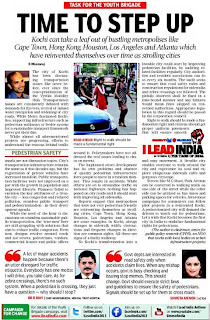The HinduThe who-cares attitude of the PWD and the KWA in restoring has resulted in frequent accidents in Kochi. Seen here is incomplete restoration of the SA Road at Vyttila Janatha. Photo: H. Vibhu
The latest move to set additional restrictions for digging up freshly laid roads is unlikely to improve the condition of roads in the district if the effectiveness of prevailing mechanisms is anything to go by.
The decision to set new riders and a calendar for such works was taken at a high level meeting of District Collectors and department heads chaired by Chief Minister Oommen Chandy earlier this week. District Collector P.I. Sheikh Pareeth said the new conditions would be applicable for important roads of the Public Works Department (PWD). The PWD will be asked to draw up an annual plan for road works and communicate it to the departments concerned at the district road coordination committee.
“Based on this plan, other departments will be given a window for carrying out work that involves digging up roads. Sanction will be given for such work only if the agencies concerned give an undertaking on a time limit for completing the work and deposit the estimated cost of road restoration,” Mr. Pareeth told The Hindu.
Asked whether the agency concerned would be penalised if the work overshot the allotted period, the Collector said it would be decided by the coordination committee.
Such a coordination committee chaired by the District Collector already exists, but has largely been reduced to a toothless arrangement. Though the committee is supposed to be informed about work involving digging up of roads by agencies such as the Kerala Water Authority or the BSNL, which are also expected to deposit restoration expenses, in many cases, the committee is hardly aware about such work.
A senior official of the PWD admitted that while the committee should be informed about all works except in emergency cases such as pipe burst, there were many such instances in which it was not done. “In fact, in many cases, the PWD is in the dark and come to know of such instances only when poorly restored roads lead to accidents. There is nothing wrong in digging up roads to repair a burst pipe since it is an essential service, but the agency concerned should see to it that the road is properly restored,” he said.
‘Flawed approach’
D. Dhanuraj, chairman, Centre for Public Policy Research, said there was a fundamental flaw in treating infrastructure developments around a road in isolation.
“The need of the hour is to develop a concept of the street and to entrust a single agency with everything from road to infrastructure developments in streets. A manual for street development along the lines of the road development manual should be drawn up and strictly adhered to while undertaking any work in the streets,” he said.
Lack of coordination
Mr. Dhanuraj said the problem, at present, was that multiple agencies were engaged for various services and no amount of discussions among those agencies would help iron out some elements that were often overlooked.
Consumer welfare activist Dejo Kappen of the Centre for Consumer Education said no new arrangements would help improve the condition of road as long as the lack of coordination among agencies persisted.
The pathetic condition of Tripunithura-Aryankavu Road and the Piravom-Nadakkavu Road, which were dug up for pipeline works, best exemplified it, he said.

